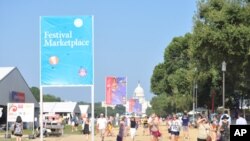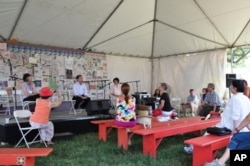Every year in Washington, D.C., visitors to the National Mall are treated to the Smithsonian Folklife Festival, which celebrates the culture and traditions of communities across the United States and the world. This year's festival in part highlights Asian Pacific Americans.
"This is a program that we talked about for many years," said James Deutsch, the program curator for the Smithsonian Institution's Center for Folklife and Cultural Heritage. "We have done programs on Asian countries. For example in the year 2007 I was the co-curator for a program on the Mekong River which featured five countries - China, Vietnam, Thailand, Laos and Cambodia. But we have never done a program on Asian Pacific Americans in the United States."
The program features music, dance, art, cooking and lectures, all presented under large, open air tents on the large grassy expanse between the U.S. Capitol building and the Washington Monument.
The musical programs are among the most popular. But many visitors are encouraged to get out of their seats and try traditional dances.
"We basically teach and perform four styles - Tibetan and Nepalese Buddhist dance, north Indian classical Kathak dance, Nepalese folk dance and of course Bollywood," said Cordula Dahal of the Nepal Dance School in nearby Fairfax, Virginia. "You cannot have a program without Bollywood. I mean Bollywood is so popular everywhere in the world."
Dahal is also passing along many dances from Nepal that might otherwise be lost over time.
"We have a great love of the art and the culture. And we want to see it continue," Dahal said. "Some of the Buddhist dances that we do are no longer being taught, even in Nepal. So it is very difficult to find a teacher. You need to find really somebody who is one or two generations older than you are who is willing to teach that," she said.
A short walk brings visitors to the Talkspeak tent, where they can listen and interact with people working to improve the Asian American community or simply become more familiar with different cultures. The Tea Room tent offers demonstrations and tips for exotic cooking.
Folklife Festival curator James Deutsch says the Smithsonian Institution has been holding the event for nearly 40 years.
"This is an annual event," he said. "It has been an annual event since 1967. The Smithsonian Folklife Festival started thanks to the efforts of S. Dillon Ripley, who was the secretary of the Smithsonian Institution, who wanted to make the Smithsonian more lively and energetic part of the ferment of the 1960s."
Deutsch added, "since 1967, we have featured dozens of countries, dozens of states and dozens of different themes. In this year 2010, it just so happened Asian Pacific Americans, Mexico and Smithsonian Inside Out all converged."
Deutsch said the program on Asian Pacific Americans offers a unique blend of culture.
"The curator for that program tells me that he is often asked how many different countries are represented. Meaning that people are thinking, well you've got Thailand, Burma, Indonesia, China, Japan, Korea and so on. His answer is one country is represented - the United States of America. Because this is a program about people, whose ancestry may come from different countries in Asia and the Pacific islands," he said.
"But they are all Asian Pacific Americans. And this program is about how they maintain cultural identity while living in the United States, and specifically living in the Washington D.C. area," Deutsch said.
Next year, the Smithsonian Folklife Festival will highlight Colombia, rhythm and blues produced in cooperation with the National Museum of African-American history and culture, and the Peace Corps on the 50th anniversary of the organization.












